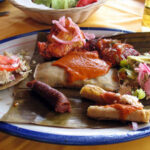Medieval Food and Dining
In the Middle Ages in Europe, what people ate depended a lot on how rich they were. Poor people (which were almost everybody) ate mainly barley. Sometimes they made their barley into bread, and sometimes into pancakes or pizza, and sometimes into barley porridge (like oatmeal) and sometimes into barley soup. But every day, breakfast, lunch and dinner, most of every meal was barley. It must have been very boring!
The food of the Middle Ages was very different from the food of today. During the Middle Ages in North Europe, the mainly used cattle and sheep for food. In South Europe, they also had fruits, vegetables, and herbs for food. They used olive oil rather than butter.
A banquet was sometimes made up of 6 courses. It provided food for everyone, not just the rich and famous. Rules were laid down for how people ate, their table manners and where they sat. They used spoons and knifes for eating. They also used trenchers, which were things like plates except they were pieces of hard bread that would soak up the blood and liquids from the chicken, turkey and other meats. A banquet was made up of many things; some of those things are in the headings that follow.
Food was preserved in a number of ways. One way was that, meats and fishes were smoked or dried. Another way of preserving was that fruits and vegetables were pickled. Meat for the winter was salted in huge wooden vats. Sometimes meat and fruit were stored together in barrels. The warmest place in the kitchen was the blazing hearth. A hearth was a huge fireplace. Food was often disguised with spices to hide the taste of rotten meat! The kitchen was a very lively place.
In the castle kitchen the cook and his staff turned the meat – pork, beef, mutton, poultry, game – on a spit and prepared stews and soups in great iron cauldrons hung over the fire on a hook and chain that could be raised and lowered to regulate the temperature. Boiled meat was lifted out of the pot with an iron meat hook, a long fork with a wooden handle and prongs attached to the side. Soup was stirred with a long-handled slotted spoon.
Meat preservation was by salting or smoking, or, most commonly and simply, by keeping the meat alive till needed. Salting was done by two methods. Dry-salting meant burying the meat in a bed of salt pounded to a powder with mortar and pestle. Brine-curing consisted of immersing the meat in a strong salt solution. Before cooking, the salted meat had to be soaked and rinsed.
In addition to roasting and stewing, meat might be pounded to a paste, mixed with other ingredients, and served as a kind of custard. A dish of this kind was blankmanger, consisting of a paste of chicken blended with rice boiled in almond milk, seasoned with sugar, cooked until very thick, and garnished with fried almonds and anise. Another was mortrews, of fish or meat that was pounded, mixed with bread crumbs, stock, and eggs, and poached, producing a kind of quenelle, or dumpling. Both meat and fish were also made into pies, pasties, and fritters.
Sauces were made from herbs from the castle garden that were ground to a paste, mixed with wine, verjuice (the juice of unripe grapes), vinegar, onions, ginger, pepper, saffron, cloves, and cinnamon. Mustard, a favorite ingredient, was used by the gallon.
The most common vegetables, besides onions and garlic, were peas and beans. Staples of the diet of the poor, for the rich they might be served with onions and saffron. Honey, commonly used for sweetening, came from castle or manor bees; fruit from the castle orchard – apples, pears, plums, and peaches – was supplemented by wild fruits and nuts from the lord’s wood. In addition to these local products, there were imported luxuries such as sugar (including a special kind made with roses and violets), rice, almonds, figs, dates, raisins, oranges, and pomegranates, purchased in town or at the fairs. Ordinary sugar was bought by the loaf and had to be pounded; powdered white sugar was more expensive.
Sometimes castles kept honey bees. Honey was used to sweeten foods and drinks. Sometimes water was channeled straight to the kitchen. Larger castles had their own fishponds, orchards, and vineyards.
The people of the middle ages ate a little worse than we do today. Though, they did have virtually the same silverware as we do and the same idea for today’s modern plate.
As much as they could, the poor people found other things to eat with their barley to make it less boring. They grew carrots and onions and cabbage and garlic to put in their soup, and they made cheese to eat with their bread and melt on their pizza, and they gathered apples and pears and mushrooms as well, so they could make apple pies or baked apples. And they tried to get honey to sweeten their treats. They grew herbs like basil and rosemary to flavor their food. Mostly poor people drank ale (kind of like beer) or beer in England and Germany, wine in France and Italy and Spain. Even the beer was made from barley!
Rich people also ate a lot of bread, but they made their bread out of wheat so it tasted better. And they had more choices of other things to eat with their bread. Rich people ate meat – pork and roast beef and stew and lamb chops and deer and rabbit. And they had spices to put on their food, expensive spices that had to come all the way from India like pepper and cinnamon. Even salt was often too expensive for poor people, and only rich people had it. In fact, when you were eating in a medieval castle, the salt would be on the table in a huge fancy salt cellar, and the rich people would sit near the salt so they could use it, while the poor people sat further down the long table and couldn’t use the salt. We still say, “above the salt” to mean a rich person.
At mealtimes, servants set up the trestle tables and spread the cloths, setting steel knives, silver spoons, dishes for salt, silver cups, and mazers – shallow silver-rimmed wooden bowls. At each place was a trencher or manchet, a thick slice of day-old bread serving as a plate for the roast meat. Meals were announced by a horn blown to signal time for washing hands. Servants with ewers, basins, and towels attended the guests.
At the table, seating followed status: The most important guests were at the high table, with the loftiest place reserved for an ecclesiastical dignitary, the second for the ranking layman. After grace, the procession of servants bearing food began. First came the pantler with the bread and butter, followed by the butler and his assistants with the wine and beer. Wine, in thirteenth century England mostly imported from English-ruled Bourdeaux, was drunk young in the absence of an effective technique for stoppering containers. Wine kept a year became undrinkable. The castle bought wine by the barrel and decanted it into jugs. Some was spiced and sweetened by the butlers to go with the final course. Ale, made from barley, wheat, or oats, or all three, was drunk mainly by the servants. A castle household brewed its own, hiring an ale-wife for the task and using grain from its own stores. At the royal court, according to Peter of Blois, the ale was not much better than the wine – it was “horrid to the taste and abominable to the sight.”
Ceremony marked the service at table. There was a correct way to do everything, from the laying of cloths to the cutting of trenchers and carving of meat. Part of a squire’s training was learning how to serve his lord at meals: the order in which dishes should be presented, where they should be placed, how many fingers to use in holding the joint for the lord to carve, how to cut the trenchers and place them on the table.
The solid parts of soups and stews were eaten with a spoon, the broth sipped. Meat was cut up with the knife and eaten with the fingers. Two persons shared a dish, the lesser helping the more important, the younger the older, the man the woman. The former in each case broke the bread, cut the meat, and passed the cup.
Etiquette books admonished diners not to leave the spoon in the dish or put elbows on the table, not to belch, not to drink or eat with their mouths full, not to stuff their mouths or take overly large helpings. Not surprisingly, in light of the finger-eating and dish-sharing, stress was laid on keeping hands and nails scrupulously clean, wiping spoon and knife after use, wiping the mouth before drinking, and not dipping meat in the salt dish. An everyday dinner, served between 10:00 A.M. and noon, comprised two or three courses, each of several separate dishes, all repeating the same kinds of food except the last course, which consisted of fruits, nuts, cheese, wafers, and spiced wine.
During the Crusades, though, the French and English and German soldiers who were fighting in West Asia ate a lot of West Asian-style food while they were there, and they got to like it. When they came home, a lot of them still wanted to have fancier food than they had had before, and they missed the oranges and lemons they had eaten in the South. So in the Late Middle Ages, European cooking became a lot more Mediterranean than it had been in the Early Middle Ages.



